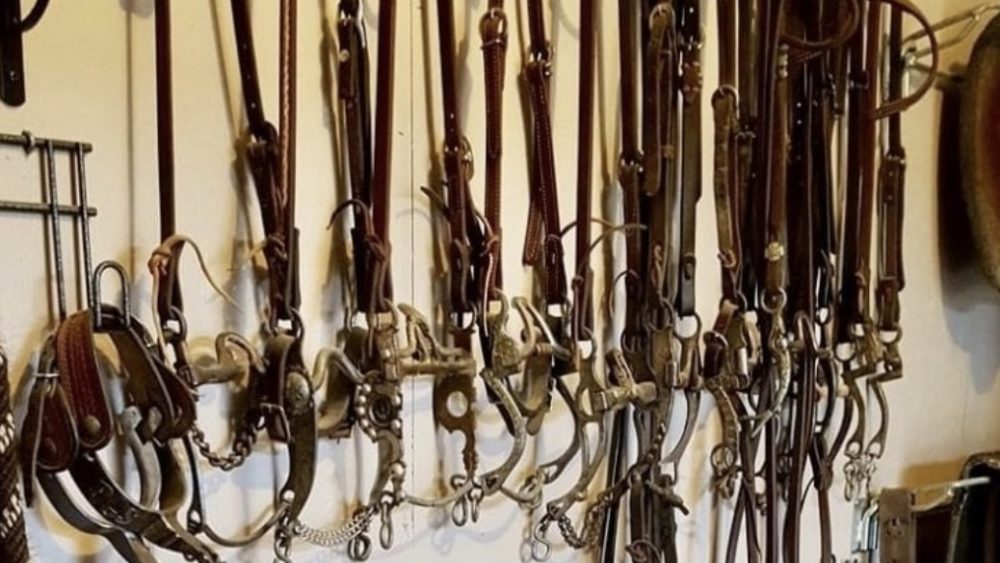Walk into most horse trainer’s tack rooms and you will likely find it: the bridle rack with countless different bits hung neatly (or, not-so neatly) on the wall. You’ve probably seen it, and immediately questioned, ‘Is there really any reason to have so many different bridles?’
Well, the answer is yes. Finding the right bit for your horse can be the difference between having a willing partner and one that is aggravated and intimidated in the arena. Having a variety to choose from is a great starting place.
GoHorseShow had the opportunity to speak with AQHA Professional Horsemen Leonard Berryhill and Gary Roberts about their advice for choosing the right bit for a horse.
Behavioral Cues
“The main criteria for finding the right bit for a horse is the way that they react to that bit,” said Leonard Berryhill, of Berryhill Quarter Horses in Talala, Oklahoma.
Though not every horse will react in the same manner if a bit is ‘too much,’ or conversely, if it is not enough, understanding the nature of the reaction is vital to evaluating your bit choice.
“I don’t want them to fear the bridle, I want them to respect the bridle,” Berryhill said. “If a horse fears the bridle, that’s where you get a lot of rearing up, or the horse throwing its head in the air.”
Gary Roberts, who trains out of Murrieta, California, said that, along with rearing up and head tossing, two major indicators that a bridle is too much for a given horse are if the horse is gapping at the mouth frequently, and if it is ‘hiding’ from the bridle. A horse that is uncomfortable with a bit will naturally seek an escape from the discomfort it is experiencing.
Conversely, if a certain bit is not enough for the horse, a rider may struggle to get an adequate response to their requests, resulting in a dull, lazy, and unwilling feel to the horse.
“As far as a bit not being enough, to me, it’s if a horse is just really pushy,” Roberts said. “If you’re trying to create roundness, or flexion, and they just feel pushy, then you need to experiment with something else.”
Switch It Up
Finding the right bit is a process that requires experimentation by the rider, because every horse will react to the same tools in a different way. Roberts said that in his training program, when he is attempting to find a bit that works best for a horse, he never starts with a more-severe option.
“We always start with less bridle and graduate up until we find something that we feel the horse is comfortable with, and we are comfortable with the response that we are getting from it,” Roberts said.
Starting with smaller bits and progressively working up to larger options is an approach that can help avoid intimidating a horse by using more bit than is likely necessary.
Similarly, Berryhill noted that he never rides a horse in the same bit every day to prevent them from getting numb to a bit that the horse works well in. Instead, he uses a variety of bits in the training process, and mainly reserves his favorites for the show ring.
“When I am searching for a correct bit on a horse, I want a bit that I can get the reaction I am looking for with as little pressure as I can,” Berryhill said. “I want to use as much bit as I need, but as little as I can get away with to make that horse respond to me.”
Though gradually moving through different types of bits may be a time-consuming process, it gives both rider and horse a chance to understand what types of bits work best and produce the desired feel in the horse.
Be Knowledgeable
The key to having an idea of which types of bits to try is being knowledgeable of the intended response each bit is designed to draw out from the horse. Depending on the horse and its needs, different bit configurations will elicit varied responses.
“If we have a horse that wants to chew on the bridle a lot, we won’t use a broken mouthpiece,” Roberts said. “I’d go to something solid, and maybe not even something with a loose shank.”
Similarly, Berryhill explained that the way a bit is made will change the response that a horse has to it.
“More important to me than who made the bit, is how the bit is made,” Berryhill said. “I’m very particular about the length of the purchase and the length of the shank, the balance in those. Each horse needs a different amount of leverage, and the more length of shank and the higher purchase that you have, the more leverage you have on this horse.”
Once you have an idea of what the horse needs to improve upon, whether it is nervous and fidgety or rigid and lazy, understanding the functions of different types of bits will help you to best address those areas of weakness and target them for improvement.
With so many possible options hanging on that tack room bridle rack, patience for a process of trial and error, and knowledge to guide the process, you are sure to find a bit that will help your horse be a willing partner in the arena.









